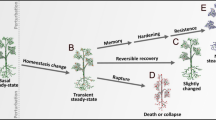Abstract
A simulation model of a trigger mechanism that reversibly switches a plant to the stress regime in response to adverse environmental effects is suggested and investigated. This mechanism is activated by an elevated level of specific cell metabolites and, by inhibiting the customary synthetic processes, actuates the formation of systems that counteract the deregulation of plant metabolism. The operation of the postulated mechanism corresponds better to the known patterns of plant transition between the normal and stress states than the operation of common triggers. The model describes the reversibility of stress response and its relation to the intensity of environmental effects. The model also suggests that the stress response in plants is aimed at stabilizing the cell level of “dangerous” stress metabolites under adverse environmental conditions and providing for the termination of plant stress after cessation of the action of a stress factor. The possible actual prototypes of the model variables are discussed and used to explain several phenomena observed in plants under stress conditions, in particular, the changes in the system of prooxidant–antioxidant equilibrium.
Similar content being viewed by others
REFERENCES
Chernavskii, D.S., Grigorov, L.N., and Polyakova, M.S., Simulation of the Trigger Scheme of Jacobe and Mono, Kolebatel'nye protsessy v biologicheskikh i khimicheskikh sistemakh (Oscillatory Processes in Biological and Chemical Systems), Frank, G.M., Ed., Moscow: Nauka, 1967, pp. 138-148.
Thornley, J.H.M., Mathematical Models in Plant Physiology, London: Academic, 1976. Translated under the title Matematicheskie modeli v fiziologii rastenii, Kiev: Naukova Dumka, 1982.
Veselova, T.V., Veselovskii, V.A., and Chernavskii, D.S., Stress u rastenii (biofizicheskii podkhod) (Plant Stress: A Biophysical Approach), Moscow: Mosk. Gos. Univ., 1993.
Veselova, T.V., Veselovskii, V.A., and Chernavskii, D.S., Plant Stress: A Biophysical Approach, Fiziol. Rast. (Moscow), 1993, vol. 40, pp. 553-557 (Russ. J. Plant Physiol., Engl. Transl.).
Smith, J.M., Mathematical Ideas in Biology, Cambridge: Cambridge Univ. Press, 1968. Translated under the title Matematicheskie idei v biologii, Moscow: Mir, 1970.
Williams, V.R. and Williams, H.B., Basic Physical Chemistry for the Life Sciences, San Francisco: Freeman, 1973. Translated under the title Fizicheskaya khimiya dlya biologov, Moscow: Mir, 1976.
Romanovskii, Yu.M., Stepanova, N.V., and Chernavskii, D.S., Matematicheskoe modelirovanie v biofizike (Mathematical Simulation in Biophysics), Moscow: Nauka, 1975.
D'yakonov, V.P., Spravochnik po MathCAD PLUS 6.0 PRO (Handbook on MathCAD PLUS 6.0 PRO), Moscow: SK Press, 1997.
Kurganova, L.N., Veselov, A.P., Sinitsyna, Yu.V., and Elikova, E.A., Lipid Peroxidation Products as Possible Mediators of Heat Stress Response in Plants, Fiziol. Rast. (Moscow), 1999, vol. 46, pp. 218-222 (Russ. J. Plant Physiol., Engl. Transl.).
Veselov, A.P., Kurganova, L.N., Nazarova, M.V., and Brilkina, A.A., The Effect of Hyperthermia on the Expression of Superoxide Dismutase Gene in Plants., Tezisy dokl. IV s''ezda obshchestva fiziologov rastenii Rossii (Abstr. IV Meet. Soc. Russ. Plant Physiol.), Moscow: Inst. Fiziol. Rast., Ross. Akad. Nauk, 1999, vol. 2, p. 759.
Selivankina, S.Yu., Romanko, E.G., Novikova, G.V., Muromtseva, D.G., and Kulaeva, O.N., Effects of Cytokinins and Other Phytohormones on the Protein Kinases Associated with Chromatin and RNA Polymerase in Barley Leaves, Fiziol. Rast. (Moscow), 1988, vol. 35, pp. 266-272 (Sov. Plant Physiol., Engl. Transl.).
Tankelyun, O.V. and Polevoi, V.V., Auxin-Induced Increase in the Protein Kinase Activity of the Microsomal Fraction from Maize Coleoptile Cells, Fiziol. Rast. (Moscow), 1996, vol. 43, pp. 201-207 (Russ. J. Plant Physiol., Engl. Transl.).
Veselov, A.P., Lobov, V.P., and Olyunina, L.N., Phytohormones during Heat Shock and Recovery, Fiziol. Rast. (Moscow), 1998, vol. 45, pp. 709-715 (Russ. J. Plant Physiol., Engl. Transl.).
Alexandrov, V.Ya., Den'ko, E.I., and Lomagin, A.G., After-Heat-Shock Dynamics of Heat Tolerance of Chloroplast Phototaxis and Cytoplasmic Movement in Plant Cells, Fiziol. Rast. (Moscow), 1990, vol. 37, pp. 133-141 (Sov. Plant Physiol., Engl. Transl.).
Author information
Authors and Affiliations
Rights and permissions
About this article
Cite this article
Veselov, A.P. Simulation Model of a Possible Trigger for Reversible Switching of the Stress Regime in Plants. Russian Journal of Plant Physiology 48, 104–110 (2001). https://doi.org/10.1023/A:1009015118298
Issue Date:
DOI: https://doi.org/10.1023/A:1009015118298




